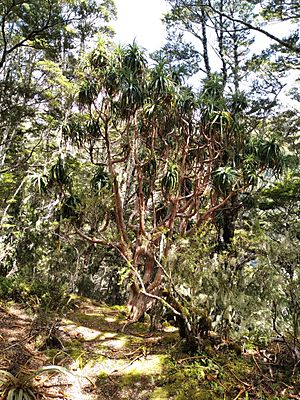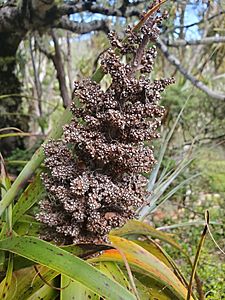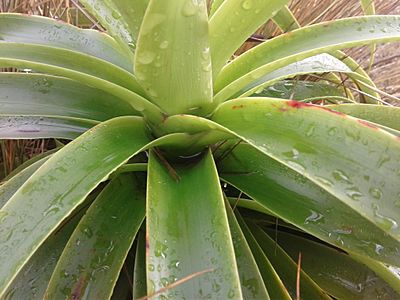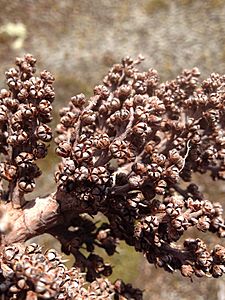Mountain neinei facts for kids
Quick facts for kids Mountain neinei |
|
|---|---|
 |
|
| Scientific classification | |
| Synonyms | |
|
D. pyramidale W.R.B.Oliv. |
Dracophyllum traversii, also called mountain neinei, grass tree, or pineapple tree, is a special plant found only in New Zealand. It can be a small shrub, only 0.2 meters tall, or a tall tree, reaching up to 13 meters! Its leaves grow in bunches at the ends of its branches, looking a bit like a pineapple or plants from the bromeliad family. This unique plant grows in both the North and South Islands of New Zealand. In the summer, it produces many red flowers, sometimes as many as 3000!
Contents
What it Looks Like
The Dracophyllum traversii can be a shrub or a tree. It has light brown bark that peels off in flakes. Its leaves are tough and leathery, about 9 to 86 centimeters long and 1.7 to 5 centimeters wide. They have tiny teeth along their edges, so small you might need to look closely to see them! Each green leaf is wrapped at its base by a green or light brown sheath.
This plant flowers from October to February. Its flowers grow in long, dense bunches called inflorescences, which can be 18 to 40 centimeters long. Each bunch can have anywhere from 500 to over 3000 red (and sometimes green) flowers! The plant then produces small, yellow-brown, egg-shaped seeds from December to May. These tiny seeds are easily carried away by the wind.
Dracophyllum traversii is a very old plant! It can live for 500 to 600 years. It is also a deciduous plant, which means it loses its leaves during its growing season, usually from December to March. It takes about two to three growing seasons for new leaves to fully grow, with each season lasting from September to April.
Plant Names and History
The Dracophyllum traversii was first officially described by a scientist named Joseph Dalton Hooker in 1867. The name Dracophyllum means 'dragon leaf'. This is because its leaves look a bit like those of the dragon tree found in the Canary Islands. The second part of its name, traversii, honors William Thomas Locke Travers. He was a lawyer, politician, explorer, and naturalist who lived in New Zealand starting in 1849.
Sometimes, scientists have different ideas about how to classify plants. As of January 2021, the New Zealand Plant Conservation Network considers Dracophyllum pyramidale to be the same species as D. traversii. However, another group, Plants of the World Online, thinks they are separate species. They believe D. traversii grows in the South Island, and D. pyramidale grows in the North Island. One study from 1987 suggested the only real difference between them was a waxy coating on the leaves of D. traversii.
Where it Grows
Dracophyllum traversii is a plant that is endemic to New Zealand, meaning it's found nowhere else in the world! You can find it in both the North Island and the South Island.
In the North Island, it grows from Waima Forest in the north, stretching south to Taumarunui, and also east to the East Cape. In the South Island, it's found in North-west Nelson and goes all the way down to Fiordland and Central Otago.
How it Lives with Others
The Kea, a smart New Zealand parrot, likes to eat D. traversii during winter. They mostly munch on the young leaves and the tips of the shoots. Some tiny larvae also eat these parts.
Interestingly, the fruit of D. traversii is rarely eaten by animals. Only about 0.01% of the fruit is eaten by larvae!
This plant often grows near other native New Zealand trees, such as Libocedrus bidwillii, Phyllocladus aspleniifolius var. alpinus, Podocarpus hallii, Metrosideros umbellata, and Olearia lacunosa.
Because D. traversii loses its leaves, the ground under these trees often gets covered with a thick layer of fallen leaves, sometimes 10 centimeters deep or more! This thick layer can make it hard for other plants to grow underneath.
Growing Your Own Dracophyllum traversii
If you want to grow Dracophyllum traversii, it's best to start from its seeds. The plant needs soil that is always moist. However, be patient! It grows very slowly and can be tricky to get started. It grows best in a spot that gets some shade and has rich, dark soil (called humus). It's not a good idea to try and move a wild Dracophyllum traversii plant, as they usually don't survive being transplanted.
Images for kids
-
The northern form of D. traversii near Gisborne.









